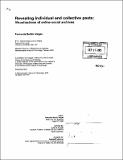| dc.contributor.advisor | Judith D. Donath. | en_US |
| dc.contributor.author | Viégas, Fernanda Bertini, 1971- | en_US |
| dc.contributor.other | Massachusetts Institute of Technology. Dept. of Architecture. Program In Media Arts and Sciences | en_US |
| dc.date.accessioned | 2007-12-07T19:22:14Z | |
| dc.date.available | 2007-12-07T19:22:14Z | |
| dc.date.copyright | 2005 | en_US |
| dc.date.issued | 2005 | en_US |
| dc.identifier.uri | http://dspace.mit.edu/handle/1721.1/33880 | en_US |
| dc.identifier.uri | http://hdl.handle.net/1721.1/33880 | |
| dc.description | Thesis (Ph. D.)--Massachusetts Institute of Technology, School of Architecture and Planning, Program in Media Arts and Sciences, 2005. | en_US |
| dc.description | Includes bibliographical references (p. 118-125). | en_US |
| dc.description.abstract | As mediated communication becomes an increasingly central part of everyday life, people have started going online to conduct business, to get emotional support, to find communities of interest, and to look for potential romantic partners. Most of these social activities take place primarily through the exchange of conversational texts that, over time, accrue into vast archives. As valuable as these collections of documents may be for our comprehension of the online social world, they are usually cumbersome, impenetrable records of the past. This thesis posits that history visualization- the visualization of people's past presence and activities in mediated environments- helps users make better sense of the online social spaces they inhabit and the relationships they maintain. Here, a progressive series of experimental visualizations explores different ways in which history may enhance social legibility. The projects visualize the history of people's activities in four different environments: a graphical chat room, a wiki site, Usenet newsgroups, and email. History and the persistent nature of online communication are the common threads connecting these projects. Evaluation of these tools shows that history visualizations can be utilized in a variety of ways, ranging from aids for quicker impression formation and mirrors for self-reflection, to catalysts for storytelling and artifacts for posterity. | en_US |
| dc.description.statementofresponsibility | by Fernanda Bertini Viégas. | en_US |
| dc.format.extent | 125 p. | en_US |
| dc.language.iso | eng | en_US |
| dc.publisher | Massachusetts Institute of Technology | en_US |
| dc.rights | M.I.T. theses are protected by copyright. They may be viewed from this source for any purpose, but reproduction or distribution in any format is prohibited without written permission. See provided URL for inquiries about permission. | en_US |
| dc.rights.uri | http://dspace.mit.edu/handle/1721.1/33880 | en_US |
| dc.rights.uri | http://dspace.mit.edu/handle/1721.1/7582 | |
| dc.subject | Architecture. Program In Media Arts and Sciences | en_US |
| dc.title | Revealing individual and collective pasts : visualizations of online social archives | en_US |
| dc.type | Thesis | en_US |
| dc.description.degree | Ph.D. | en_US |
| dc.contributor.department | Program in Media Arts and Sciences (Massachusetts Institute of Technology) | |
| dc.identifier.oclc | 66464870 | en_US |
